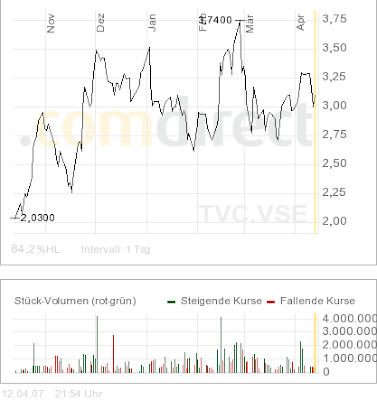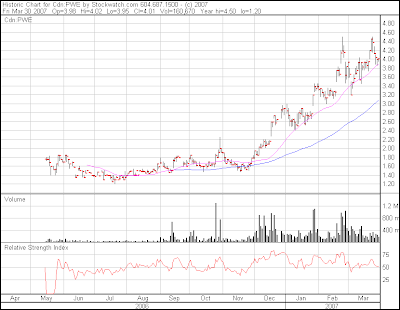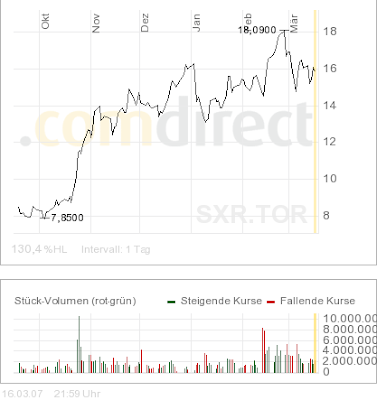Tournigan Gold Corp
Tournigan Gold Corp. (TSX:TVC) & (FSE:TGP)
Share price: CAD 3.10 (april 12, 2007)
Number of shares: 112 million
Market cap: CAD 347.2 million
Resources: 28.6 Mlbs (NI 43-101 Inferred and historical)
Price per pund U3O8: USD 10.4
Estimated production start: Late 2009
Estimated production output in 2010:
Estimated revenue 2010 (U3O8 = $95) : USD
Estimated production costs per lb: $ 9.15
Estimated profit 2010: CAD
Price target 2010 at p/e 10: CAD 10 (
Price target at U3O8 in ground (10 USD per pound): CAD 2.98
12 month price target: CAD 5 (upside 61 %)
My analysis
The company’s resource and production estimate will be higher when all their properties have been explored and all their projects come online. Another upside is the gold projects, where they are planning to produce

Tournigan Gold’s project presentation:
Vision: To increase shareholder value through exploration and to develop advanced projects into producing mines.
Nearing Development: Tournigan has a strong presence in Europe with its Kremnica gold and Jahodna uranium/molybdenum projects in
Exploration Assets: Tournigan's asset mix also includes a pipeline of earlier-stage uranium projects in
BRIEF PROJECT OVERVIEW
Kremnica Gold Project --
Kremnica was one of
Since that time, Tournigan has advanced Kremnica along a two-pronged path:
- Exploring new target zones
- Developing the main Sturec open-pit deposit and its peripheries with the goal of putting it back into production
In May 2006, Beacon Hill Consultants tabled a NI 43-101-compliant measured and indicated resource estimate within the area of the existing Sturec gold deposit.
This estimate outlines 959 thousand ounces of gold and 7.7 million ounces of silver (measured and indicated) hosted within 18.8 million tonnes of material with an average grade of 1.59 g/t gold and 12.78 g/t silver. An additional 272 thousand ounces of gold and 1.5 million ounces of silver are classified in the inferred category - (6.4 million tonnes averaging 1.32 g/t gold and 7.42 g/t silver). The stated resources are based on a cutoff of 0.75 g/t gold.
Development schedule:
Tournigan is now in the midst of pre-feasibility, environmental and socio-economic studies at Kremnica. The project development plan is then expected to advance through feasibility studies, construction and production. The entire plan is estimated to be completed by the second half of 2008.
Detailed Kremnica property description
Click here to download Technical Report on Kremnica gold project resource estimate prepared by Beacon Hill (1988) Ltd.
Jahodna Uranium Project -- Slovak Republic -- 100% owned
In June 2005, Tournigan acquired the Jahodna uranium deposit and 32 km2 of surrounding exploration licenses.
Uranium mineralization was originally discovered at Jahodna in 1985. Three stages of exploration occurred between 1985 and 1992 that outlined historic uranium and molybdenum resources. Further studies were conducted on the property until 1996. Mineralization appears to remain open along strike as well as to depth.
Following
This report was released in late March of 2006 and outlined an inferred resource containing 18.2 million pounds of Uranium Oxide (U3O8) hosted within 1.25 million tonnes of material with an average grade of 0.66% U3O8 at a cutoff of 0.035% U3O8.
Jahodna project strategy:
- Drill additional in-fill holes to generate additional information about the deposit and possibly increase the existing resource.
- Complete step-out drilling of the main Jahodna deposit with the goal of increasing the strike length of the deposit.
- Explore for new zones of mineralization.
- Conduct necessary steps to move the deposit into production.
Detailed Jahodna property description Current exploration activities
Curraghinalt Gold Project --
Tournigan purchased the Curraghinalt gold project in April of 2003 from Strongbow Exploration.
Previous exploration at Curraghinalt in the 1980's and 1990's consisted of more than
Aggressive exploration and drilling campaigns since Tournigan's involvement in 2003 have not only confirmed and expanded the historic Curraghinalt resource estimate but also identified three new parallel gold-bearing vein systems.
A NI 43-101 inferred resource estimate on the deposit was completed by John Tully & Associates in January of
Curraghinalt project strategy:
- Expand and upgrade existing resource via in-fill and step out drilling as well as underground exploration development work.
- Complete preliminary assessment.
- Advance project through requisite steps for permitting, building and operating an underground gold mine.
Detailed Curraghinalt project description
Earlier-stage Exploration Assets
Novoveska Huta Uranium Project --
Svabovce and Spissky Stiavnik Uranium Projects --
Uranium Portfolio in
Brehov Gold/VMS project --
AuEx joint venture with gold projects --
Sprott Asset Management's Uranium report, with Tournigan price target at CAD 4.40.
Ressource Capital Research have an Uranium Sector Review as well with analysis of Tournigan and many other uranium companies.








